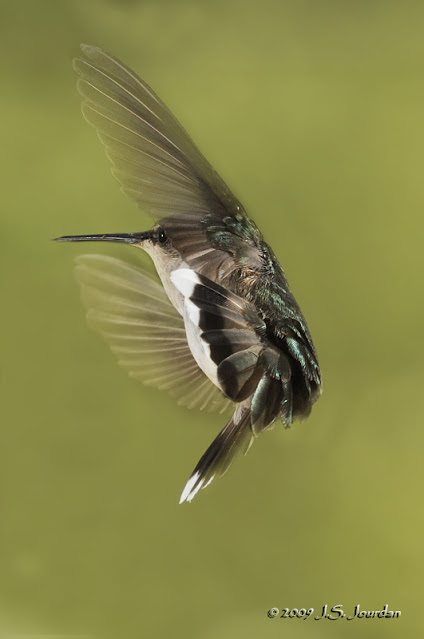Hummers, pt. 2 - 20 Aug 2009
I found this thread discussing the wireless capabilities of the SB-600 and SB-800, and it references Ken Rockwell's fine article regarding how to set up both flashes for wireless operation. He also shows where on the Nikon D300 to set up the camera's built-in flash unit to act as the trigger.
Martin Dollenkamp has a nice blog writeup discussing his setup for hummingbird photography using wireless flash units. He indicates using the flashes in 'Manual' mode, with power output set to 1/4 to 1/8 to stop wing action. I didn't try this, but will next time (see below as for why).
I arrived at the Clark residence shortly before 4pm and set up both flashes on the back deck using a couple of bogen tripods. I tried to set them as close to the railing so they wouldn't look so obtrusive to the arriving hummers. I removed the feeders that were on their kitchen and deck windows so the birds would concentrate on the one next to the hanging flower baskets. I positioned myself about 6 feet away under another hanging basket, and proceeded to stand motionless for the next 1.5 hrs hoping to get a few shots. A couple of test shots w/ the camera and flashes set to i-TTL confirmed proper exposure of the nectar feeder. Camera was set to ISO 200 and Aperture-priority (f/11).
I restrained myself from shooting when the first bird appeared. I wanted her (in this case) to get comfortable w/ my presence and not get spooked by a sudden camera flash. She fed a few times, each time hovering back from the feeder before moving back in. On her second trip back, I attempted a few bursts, and surprisingly, the flashes did not seem to spook her. She kept using the port facing me, so all I got were rump and back shots.
A bit while later a male Ruby-throat appeared, but proved to be a challenging foe. He first perched on the overhead wire above the deck, but was blocked from view by the lattice-work. When he came in to feed, he kept using the far port, so I only ever got to see his tail. I resisted any photography until he appeared into view, but he refused to expose himself to my lens.
At one point I had 2 hummers feeding at the tiny nectar feeder embedded in the hanging basket next to my head. I had to stand motionless for several minutes as they fed just inches from my ear, and expected to find hummingbird poop on my hat afterward (I didn't).
Each time a female or juvenile bird would come into feed they would use the port facing me, or the right side. Each time the male would come in, he would use the far port and avoid me.
I soon left them to feed undisturbed and returned the feeders to their original locations (sorry Jo, the high winds knocked them over and spilled the sugar water....).
While reviewing images I found that the flash units were not fast enough to stop wing motion. As such, I got a number of nice imges w/ 4-winged hummers. I had to Photoshop these images to remove the wing-shadows, but was happy w/ the exposures and details I was able to capture on my first 'official' attempt. I'll have to go back and set the flashes to manual mode and see if I can get better stop-action shots. Shadows may be a problem w/o the additional flash units, but I'll address that later.
3154 O'Hara Road, Carleton, MI, Monroe, Michigan, US
Aug 20, 2009 6:00 PM - 6:45 PM
Protocol: Stationary
Checklist Comments: yard
1 species
Ruby-throated Hummingbird (Archilochus colubris) 2
View this checklist online at https://ebird.org/checklist/S1
This report was generated automatically by eBird v3 (https://ebird.org/home)
Aug 20, 2009 6:00 PM - 6:45 PM
Protocol: Stationary
Checklist Comments: yard
1 species
Ruby-throated Hummingbird (Archilochus colubris) 2
View this checklist online at https://ebird.org/checklist/S1
This report was generated automatically by eBird v3 (https://ebird.org/home)








Great work that speed light is the ticket you versatile Jerry great work!!1
ReplyDelete